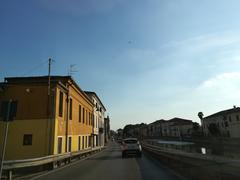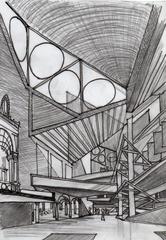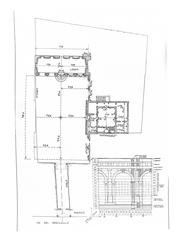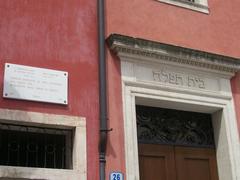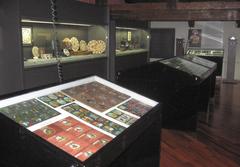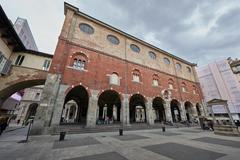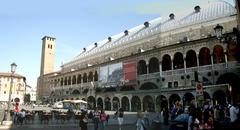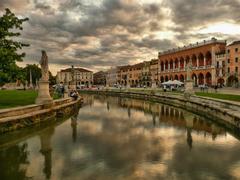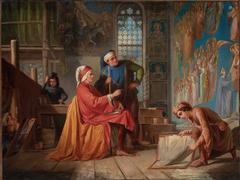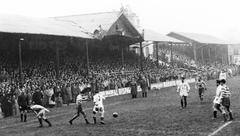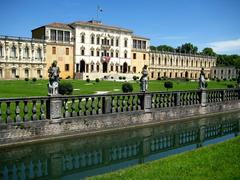Piazza Capitaniato Visiting Hours, Tickets, and Travel Tips
Date: 31/07/2024
Introduction
Piazza Capitaniato, also known as Piazza dei Signori, is a central square in Padua, Italy, renowned for its historical, architectural, and cultural significance. This guide provides essential information on the best times to visit, ticketing details, and travel tips, while delving into the rich history and importance of this iconic site. From its evolution under Venetian rule to its role as a hub of intellectual and cultural activity, Piazza Capitaniato stands as a testament to Padua’s vibrant past and dynamic present.
The square’s historical roots trace back to the Roman era, evolving through medieval and Renaissance periods into a pivotal political and social center. The Palazzo del Capitaniato, a striking Renaissance building, and the Torre dell’Orologio, an astronomical clock tower, are standout architectural features that reflect the artistic achievements of the time. The piazza’s proximity to the University of Padua, one of the oldest universities in the world, further enhances its educational and cultural significance (Lonely Planet, Padova.com, Renato Prosciutto).
Visitors can explore historical monuments and enjoy local culture through various events, markets, and festivals. This guide provides insights into the historical background, visitor information, and travel tips to ensure a memorable and enriching experience.
Table of Contents
- Introduction
- Historical Background of Piazza Capitaniato, Padua, Italy
- Venetian Domination and Architectural Evolution
- The Astronomical Clock Tower
- The Role of the Capitano and Podestà
- Artistic and Cultural Significance
- Influence of Notable Figures
- The Reggia Carrarrese and Its Transformation
- The Clock Tower’s Unique Features
- The Palazzo della Ragione
- The Jewish Ghetto
- The University of Padua
- Visitor Information
- FAQ Section
- Conclusion
Historical Background of Piazza Capitaniato, Padua, Italy
Venetian Domination and Architectural Evolution
Piazza Capitaniato became a focal point of Venetian authority when Padua fell under Venice’s control in 1405. The Lion of Saint Mark, a prominent emblem of Venetian power, adorns the Palazzo del Capitaniato (Lonely Planet).
The Palazzo del Capitaniato, designed by Giovanni Maria Falconetto in the 16th century, features a triumphal arch added in 1531, connecting Piazza dei Signori with Piazza Capitaniato. This arch, made of Istrian stone and supported by four Doric columns, was modeled after ancient Roman triumphal arches (Padova.com).
The Astronomical Clock Tower
The Astronomical Clock Tower, or Torre dell’Orologio, stands between the Palazzo del Capitaniato and the Palazzo dei Camerlenghi. The original clock, created in 1423 by Giovanni Dondi, indicates hours, minutes, months, days of the week, and phases of the moon (Renato Prosciutto). Rebuilt in 1428, the tower features symbols of the Republic of Venice, including the Lion of Saint Mark (Padova.com).
The Role of the Capitano and Podestà
The Palazzo del Capitaniato served as the residence of the Capitano and the Podestà, who were responsible for the administration and governance of Padua during the Venetian period. The building was constructed on the ruins of the Reggia Carrarrese, which housed various facilities for soldiers (Renato Prosciutto).
Artistic and Cultural Significance
Piazza Capitaniato is enriched by its artistic and cultural heritage, including the Church of San Clemente and the Chapel with frescoes by Guariento and Giusto de’ Menabuoi (Padova.com).
Influence of Notable Figures
Figures such as Galileo Galilei, who lectured at the University of Padua, and Francesco Petrarca have significantly contributed to Padua’s intellectual landscape (Sacred Wanderings).
The Reggia Carrarrese and Its Transformation
The Reggia Carrarrese was repurposed to accommodate the Venetian Capitanio and Paduan administration after Padua came under Venetian control. This transformation included the addition of the Clock Tower and the Triumphal Arch (Padova.com).
The Clock Tower’s Unique Features
The Astronomical Clock Tower features a 24-hour dial, day of the month, phases of the moon and sun, and the movement of the planets. Notably, the Zodiac sign for Libra is missing (The Travel Folk).
The Palazzo della Ragione
Adjacent to Piazza Capitaniato, the Palazzo della Ragione once housed the town hall and market hall. Its main hall is adorned with frescoes depicting scenes from medieval life, the zodiac, and religious imagery (Every Steph).
The Jewish Ghetto
The Quartiere dell’Antico Ghetto Ebraico, established in 1603, was a hub of Jewish life and tradition in Padua (Sacred Wanderings).
The University of Padua
The University of Padua, founded in 1222, is one of Europe’s oldest and most prestigious universities. It has been a center of learning and innovation, with notable scholars such as Galileo Galilei and Elena Lucrezia Cornaro Piscopia (Every Steph).
Visitor Information
Visiting Hours and Tickets
Piazza Capitaniato is generally accessible to the public at all times. Specific buildings, such as the Palazzo del Capitaniato and the Astronomical Clock Tower, may have restricted hours. For the latest information on visiting hours and ticket prices, check the official website or contact the local tourism office.
Guided Tours and Travel Tips
Guided tours are available and often include visits to nearby attractions such as the Palazzo della Ragione and the Jewish Ghetto. It is recommended to book tours in advance, especially during peak tourist seasons.
Nearby Attractions and Photographic Spots
Explore nearby attractions such as the Scrovegni Chapel, known for its stunning frescoes by Giotto, and the Prato della Valle, one of the largest squares in Europe. Piazza Capitaniato offers numerous photographic spots, particularly the Astronomical Clock Tower and the Triumphal Arch.
Accessibility
Piazza Capitaniato is accessible to visitors with mobility issues, although some historical buildings may have limitations. Check accessibility options in advance and plan your visit accordingly.
FAQ Section
What are the opening hours for Piazza Capitaniato? Piazza Capitaniato is generally accessible to the public at all times, but specific buildings such as the Palazzo del Capitaniato and the Astronomical Clock Tower may have restricted hours. Check the official website for the latest information.
Are there guided tours available at Piazza Capitaniato? Yes, guided tours are available and often include visits to nearby attractions. It is recommended to book in advance.
What are some nearby attractions to visit? Nearby attractions include the Scrovegni Chapel, the Palazzo della Ragione, and the Prato della Valle.
Is Piazza Capitaniato accessible for visitors with mobility issues? While the square itself is accessible, some historical buildings may have limitations. It is advisable to check accessibility options in advance.
Conclusion
Piazza Capitaniato in Padua is a site of immense historical and cultural significance. Its evolution under Venetian domination, the architectural marvels of the Palazzo del Capitaniato and the Astronomical Clock Tower, and the contributions of notable figures such as Galileo Galilei all contribute to its rich heritage. Visitors can explore historical buildings, admire artistic treasures, and gain a deeper understanding of Padua’s vibrant past.
For more information and updates, consider downloading the Audiala mobile app, checking out related posts, or following us on social media.
References
- Lonely Planet, n.d., Lonely Planet
- Padova.com, n.d., Padova.com
- Renato Prosciutto, n.d., Renato Prosciutto
- Every Steph, n.d., Every Steph
- Sacred Wanderings, n.d., Sacred Wanderings
- The Travel Folk, n.d., The Travel Folk


